Antonov An-2
| An-2 | |
|---|---|
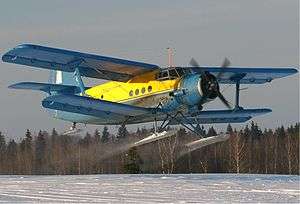 | |
| An-2R on skis allowing operations in the snow | |
| Role | Agricultural and utility aircraft |
| Manufacturer | Antonov |
| Designer | Oleg Antonov |
| First flight | 31 August 1947[1] |
| Status | Series production may still continue in China as the Shijiazhuang Y-5;[2] engine refitting project underway[3] |
| Primary users | Soviet Union North Korea China Many others |
| Produced | 1947–2001 |
| Number built | 18,000+[4] |
| Variants | Antonov An-3 |
The Antonov An-2 (Russian nickname: "Annushka" or "Annie"; "kukuruznik" - corn crop duster; USAF/DoD reporting name Type 22,[5] NATO reporting name Colt.[6]) is a Soviet mass-produced single-engine biplane utility/agricultural aircraft designed and manufactured by the Antonov Design Bureau beginning in 1946.[4]
Design and development
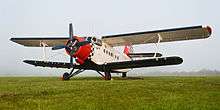
The An-2 is used as a light utility transport, parachute drop aircraft, agricultural work and many other tasks suited to this large slow-flying biplane. Its slow flight and good short field performance make it suited for short, unimproved fields, and some specialized variants have also been built for cold weather and other extreme environments. The Guinness Book of World Records states that the 45-year production run for the An-2 was for a time the longest ever for any aircraft — and challenging the well over two decades-long run of the much lighter, late-1920s origin Polikarpov Po-2 biplane it was intended to replace — but the An-2's production duration run record was itself recently exceeded by the four-turboprop-engined, 1954-origin Lockheed C-130 Hercules military transport.[4]
The Antonov An-2 was designed to meet a 1947 Soviet Ministry of Forestry requirement for a replacement for the much lighter, largely wooden-airframed Po-2, which was used in large numbers in both agricultural and utility roles. Antonov designed a large single bay biplane of all-metal construction, with an enclosed cockpit and a cabin with room for seats accommodating twelve passengers. The first prototype, designated SKh-1 and powered by a Shvetsov ASh-21 radial engine, flew on 31 August 1947. The second prototype was fitted with a more powerful Shvetsov ASh-62 engine, which allowed the aircraft's payload to be significantly increased from 1,300 to 2,140 kg (2,870 to 4,720 lb), and in this form it was ordered into production.[7]
Initial Soviet production was at State Factory 473 in Kiev, Ukrainian SSR where the bulk of up to 5,000 units had been produced by 1960. Later Soviet production (after 1965, of model An-2M especially) was at State Factory 464 at Dolgoprudniy, Russian SFSR. After 1960, however, most An-2s were built at Poland's WSK factory in Mielec, with over 13,000 made there before full production ended in 1991. Limited production from parts stocks, as well as spares and maintenance coverage continued until 2001, when four aircraft were produced for Vietnam.[8] China also builds the An-2 under licence as the Shijiazhuang Y-5.[4] It has been occasionally and erroneously reported that there was East German production of the An-2. While An-2s were extensively refurbished in East Germany, there were no new aircraft built there.
The An-2 was designed as a utility aircraft for use in forestry and agriculture. However, the basic airframe is highly adaptable and numerous variants have been developed. These include hopper-equipped versions for crop-dusting, scientific versions for atmospheric sampling, water-bombers for fighting forest-fires, flying ambulances, float-equipped seaplane versions and lightly armed combat versions for dropping paratroops.[9] The most common version is the An-2T 12-seater passenger aircraft. All versions (other than the An-3) are powered by a 750 kW (1,010 hp) nine-cylinder Shvetsov ASh-62 radial engine, which was developed from the Wright R-1820.[4] It uses 43 gallons of avgas per hour.[9]
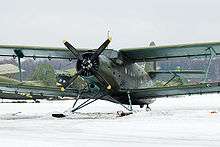
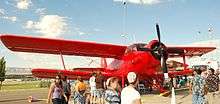
The An-2 has design features which make it suitable for operation in remote areas with unsurfaced airstrips:
- It has a pneumatic brake system (similar to those used on heavy road vehicles) to stop on short runways.[4]
- It has an air line fitted to the compressor, so the pressure in the tires and shock absorbers can be adjusted without the need for special equipment.[4]
- The batteries are large and easy to remove, so the aircraft does not need a ground power unit to supply power.[4]
- There is no need for an external fuel pump to refuel the aircraft, as it has an onboard pump that allows the tanks to be filled from simple fuel drums.[4]
- It has a minimum of complex systems. The crucial wing leading edge slats that give the aircraft its slow flight ability are fully automatic, being held closed by the airflow over the wings. Once the airspeed drops below 64 km/h (40 mph), the slats will extend because they are on elastic rubber springs.[4]
- Take-off run: 170 m (560 ft), landing run: 215 m (705 ft) (these numbers will of course vary depending on take-off/landing weight, outside air temperature, surface roughness, and headwind).[4]
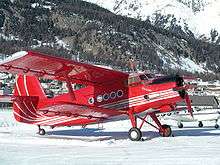
A note from the pilot's handbook reads: "If the engine quits in instrument conditions or at night, the pilot should pull the control column full aft and keep the wings level. The leading-edge slats will snap out at about 64 km/h (40 mph) and when the airplane slows to a forward speed of about 40 km/h (25 mph), the airplane will sink at about a parachute descent rate until the aircraft hits the ground." [4]
The An-2 indeed has no stall speed quoted in the operating handbook. Pilots of the An-2 say one can fly the aircraft in full control at 48 km/h (30 mph) (as a contrast, a modern Cessna four-seater light aircraft has a stall speed of around 80 km/h (50 mph)). This slow stall speed makes it possible for the aircraft to fly backwards (if the aircraft is pointed into a headwind of, say, 56 km/h (35 mph), it will travel backwards at 8.0 km/h (5 mph) whilst under full control).[4]
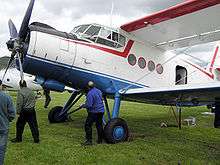
Since the collapse of the Soviet Union and the Eastern European communist states, most airlines in these areas have been withdrawing their An-2s from service, as some of these aircraft are now over 40 years old and the production of avgas had decreased.[9] Private operators are still using the planes, as their stability, capacity and slow-flying ability make them very popular, for instance for skydiving.[4][9]
In the early 1980s Antonov experimented with a development of the An-2 powered by a modern turboprop engine. The unit used was a 1,080 kilowatts (1,450 hp) Glushenkov engine and aircraft fitted with this engine were fitted with a longer, more streamlined nose to accommodate it. See Antonov An-3 article for more information.[4]
In 2013 Antonov announced that it had successfully flown for the first time a new version of the An-2 dubbed the An-2-100 fitted with a 3-blade reversible propeller and a 1500 shp Motor Sich MS-14 turboprop running on kerosene rather than Avgas which is no longer produced in CIS countries.[10]
Whilst their high noise levels, increasing maintenance costs, high fuel consumption[9] and unsophisticated nature (the pre-flight checks alone take between 30 and 40 minutes) make them obsolete for commercial service in Europe, the large number of aircraft available means that prices are low (from as little as US$30,000 for a serviceable example). This makes them ideal for the developing world, where their ability to carry large loads into short airstrips makes them assets to airlines on a budget. Many ex-Aeroflot An-2s work as regional airliners in Africa, Central and South America, Cuba and southeast Asia.[4]
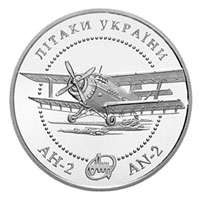
North Korea has a number of the aircraft. In a war they could possibly be used to parachute or deliver special forces troops behind enemy lines for sabotage operations.[4]
The An-2's ability, looks and flying characteristics, and its status as one of the world's biggest single-engined production biplanes, mean that demand for the An-2 is increasing in Western Europe and the United States, where they are prized by collectors of classic aircraft, making it an increasingly common sight at airshows. Many western countries prohibit the use of the An-2 commercially because the aircraft has not been certified by the relevant national aviation authorities. These restrictions vary by country, but all prevent the An-2 being used for any 'for profit' purpose, with the exception of the United States, where An-2s imported since 1993 are limited to experimental certification,[9] but PZL-built An-2s are exempt from this restriction due to a bilateral agreement with Poland.[4]
Modernization and refitting projects
In 2013, Antonov received orders for upgrading "hundreds" of the An-2 planes still in operation in Azerbaijan, Cuba and Russia to the An-2-100 upgrade version.[3]
The Siberian Research Institute of Aviation (SIBNIA) has test flown a highly modified Antonov An-2 with carbonfibre winglet-like braces and carbonfibre wing structures. This is to demonstrate the aerodynamic and structural changes planned for an An-2 replacement, Sukhoi has announced on 10 June 2015. The aircraft was equipped with a five-bladed turboprop engine, most probably the Honeywell TPE331 already installed on a modernized version of the An-2 that entered service in 2014. The autoclave-cured carbonfibre composite materials – including wing panels, spars and ribs – were produced by the Novosibirsk Aviation Plant. Sukhoi says the design change improved the speed of the An-2 by 50%, and testing also has shown the minimum flying speed of the aircraft is “close to zero”.[11]
Operational history

The An-2 was used by combat services in the Korean War. During the 1960s an An-2 attempting to engage South Vietnamese naval units was shot down by an F-4 Phantom II under the control of an Air Intercept Controller (AIC) on the USS Long Beach.[4]
On 12 January 1968, a clandestine TACAN site (call sign: Lima Site 85/Phou Pha Ti) installed by the United States Air Force in Northern Laos for directing USAF warplanes flying from Thailand to Vietnam was attacked by three North Vietnamese An-2s. Two An-2s fired on the outpost using machine guns and rockets while a third An-2 orbited overhead to survey the assault. An Air America Bell UH-1B, XW-PHF, resupplying the site chased the two attacking aircraft. By using an AK-47 the American crew (Ted Moore Captain, Glen Wood kicker) succeeded in shooting down one of the An-2s while the second aircraft was forced down by combined ground and air fire and crashed into a mountain. The surviving Antonov returned to its home base, Gia Lam, near Hanoi.[12]
During the Croatian War of Independence in 1991, a few old Antonov An-2 biplanes used for crop-spraying were converted by the Croatian Air Force to drop makeshift boiler bombs and were used in supply missions to the town of Vukovar and other besieged parts of Croatia.[13] The chief advantage for the An-2 was that they could take off and land in small or improvised airstrips. They were also used to drop supplies by parachute on isolated garrisons. At least one was shot down on 2 December 1991 over Vinkovci, eastern Slavonia, by Serbian SAM missiles, purportedly SA-6s.[14][15] Following the shootdown, the flights over Serbian lines ceased, due to the presence of TV guided SA-6. The previous radar guided AA systems were avoided by keeping the airplane's speed below 140 km/h, the speed of objects that radars were programmed to erase from the screen.
Civil Aviation
Estonia
During the Soviet Union era the An-2 was used as a short-range air-liner for regular flights between the towns of Kuressaare and Kärdla, which reside on separate islands, Saaremaa and Hiiumaa. A peculiarity of the plane was that whenever it was a bit more windy, the plane flew just fine but passengers were vomiting due to the rocking.
Variants
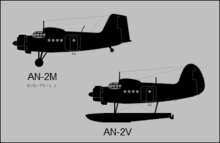
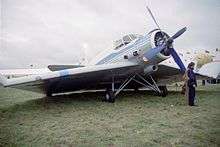
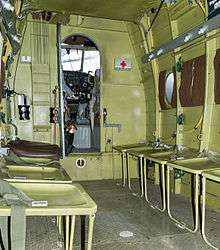
Soviet / Polish production
- Izdeliye F – The in-house designation for the An-2NAK observation aircraft which was later re-designated An-2K and/or An-2F.[4]
- Izdeliye K – A prototype weather reconnaissance/research aircraft with an observers cockpit immediately forward of the fin above the rear fuselage. First flown on 21 March 1948 'Izdeliye K' was found to be under-powered and unable to carry out its intended mission at high altitude, the aircraft was abandoned after a landing accident in October 1948. The concept was resurrected in 1954 as the 'An-2ZA' / 'An-6 Meteo'.[4]
- Izdeliye T – The original design concept originated at OKB-153 in Novosibirsk.
- Izdeliye Sh – The in-house designation for the 'Izdeliye T' (presumably to confuse spies or infiltrators) design project at Novosibirsk.[4]
- SKh-1 – the original designation of the An-2 used during the design phase of the project before the OKB had been named after Antonov.[4]
- An-2A – Developed from the An-2A for use as a Balloon interceptor to intercept reconnaissance balloons from, US intelligence assets, over-flying the USSR. The prototype was converted from a Kiev built An-2 (c/n 110347315) using the Turbo-charged Ash-62IR/TK of the 'An-6 Meteo' and a combined searchlight/gun turret mounted on top of the rear fuselage, which mounted either a single Gryazev-Shipunov GSh-23 23mm calibre twin-barrelled cannon or a single Afanas'yev A-12.7 12.7mm calibre heavy machine-gun.[4]
- An-2E (Ekranoplan – wing in ground effect)(first use of the designation) – One of a series of projects from the early 1970s for WIG (Wing In Ground effect) derivatives of the An-2, designed at the TsLST (Tsentral'naya Laboratoriya Spasatel'noy Techniki – central laboratory for new types of rescue equipment).
.jpg) The Antonov An-2E prototype ekranoplan
The Antonov An-2E prototype ekranoplan - An-2E (second use of the designation) – An Ekranoplan conversion (Russian: Ан-2Э) of an An-2P (RA-84692). The fuselage was retained and a large trapezoidal monoplane wing having extended wingtips with approx 45° dihedral, attached to the lower wing attachment points. The prototype conversion was intended to be a floatplane; however, its first public appearance was as a landplane with the standard An-2 undercarriage. Jointly developed by the Moscow Aviation Institute, MARZ (Moskovskiy Aviaremontnyy Zavod – Moscow Aircraft Overhaul Plant) and The TSZP-Saturn research institute the An-2E was also known as EA-00078. Power was supplied by the standard ASh-62IR radial engine with AV-2 propeller, but production versions were intended to be powered by automotive diesel engines of around 580 hp.[4][16]
- An-2F – Developed concurrently with the An-2 prototype, 'Izdeliye F' was an experimental artillery-observation aircraft with a twin-tail, ventral observer's position and dorsal defensive machine-gun position. The initial service designation of An-2NAK was changed to An-2F once post test flight modifications had been carried out. Two prototypes were built, with the first completed in the summer of 1948, but flight testing was delayed to April 1949 due to the need to incorporate modifications called up from the standard An-2 flight test programme. The flight test of the An-2F showed that the aircraft met all the requirements of the specification, but helicopters were demonstrating that they could perform the artillery correction role without the need to provide fixed base airstrip for them to operate from, thus the An-2F was not proceeded with and the two prototypes were retained by the Antonov bureau for hack duties with one later serving as a flying wind tunnel to investigate para-dropping from the Antonov An-8 twin-turboprop transport.[4]
- An-2F (second use of designation) – A VTOL project with vertical thrust to be provided by a Mikulin AM-9 turbojet in the rear fuselage.[4]
- An-2F (third use of the designation) – A proposed photo-mapping aircraft project, from the early 1990s, similar to the An-2PF equipped with one of five alternate cameras. Overall control was to have been by IBM 286 computer and the camera could be augmented or replaced by a thermal imaging system, Infra-Red imaging system, AP-6E autopilot,LDI-3 laser rangefinder and/or a GPS global positioning system.[4]
- An-2G (a.k.a. An-2Geo) – During 1974 WSK-Mielec developed a geo-physical survey aircraft for the Polish State Geophysical Survey Agency (Państwowe Przedsiębiorstwo Poszukiwań Geofizycznych), with equipment for measuring Magnetic fields, radiation and other instruments for prospecting. Adapted to fly in tropical latitudes at low altitude the 'An-2G' could fly for six hours and two were used for survey work in Nigeria in 1974.[4]
- An-2L (Lesozashchita – forestry protection) – A fire bomber variant with three cassettes each holding 120 ampoules, containing 1litre (34 fl.oz.) of fire-retardant which were dropped as required. Trials revealed that this system was inefficient and further work was abandoned.[4]
- An-2LL (Letayuschaya Laboratoriya – flying laboratory) – Any of a number of An-2s used as testbeds for various equipment. One An-2SKh (RA-70547), modified by the State Research Institute of Aircraft Systems. (GosNII AS – Gosudarstvennyy Nauchno-Issledovatel'skiy Institut Aviatsionnykh Sistem), for environmental research, had a lateral observation blister which has often caused the aircraft to be misidentified as an An-2PF.[4]
- An-2LP (Lesopozharnyy – forest firefighter) – A single prototype converted from an An-2V floatplane, with 630 litre(139 Imp.Gal.) water tanks in each float for dropping on fires. The water tanks could be re-filled in flight, as the aircraft skimmed the surface of suitable bodies of water. Prior to dropping an alkaline wetting agent (NP-1 Sulphanol) was added to the water which was released through the scoops which also picked up the water to refill the tanks. Ten production aircraft were built seeing service in the Siberian and Far East regions of the USSR.[4]
- An-2LV (Lesnoj Vodnyj – forest hydroplane) – A firefighting waterbomber.[4]
- An-2M (Polish:[samolot] Morski – seaplane) – Polish production of the An-2V floatplane, designated An-2M, (not to be confused with the Soviet designation An-2M). Also known as the An-2W.[4]
- An-2M (Modifitsirovannyy – modified) – The designation An-2M was also used in the USSR for a much improved agricultural crop-sprayer/duster. The An-2M featured an all-duralumin welded and bonded fuselage, lockable tailwheel, enlarged fibre-glass hopper, Shvetsov ASh-62 radial engine with power take off to an auxiliary gearbox to drive the dusting/sprayignequipment, an angular fin of increased area and a hermetically sealed cockpit with no access to the cabin/hopper area. The hopper capacity was increased 42% to 2,000Litres (440Imp.Gal.) delivering product through an outlet enlarged to 400 mm (15 1⁄2 in) with dry product being fed to two dusting outlets at the tips of the lower wings. Due to lack of capacity at the Kiev factory and WSK-Mielec the An-2M was manufactured at DMZ N0.464 (Dolgoproodnyy Machinery Factory No.464) to the north of Moscow.[4]
- An-2P (Polish: Pasażerski – passenger) (Russian: Passazhirskiy – passenger) – Soviet and Polish production of a standard passenger variant. Soviet production An-2P's had 10 permanently installed seats in a heated insulated cabin. Polish production aircraft had 12–14 seats, two jump seats for children and a baby cot. A total of 837 An-2P's were built.[4]
- An-2P (Protivopozharnij – fire-fighting with water) – A fire-fighting aircraft with a dumpable hopper filled with water and/or retardant.[4]
- An-2PD-5 (Polish: Pasażerski [samolot] Dyspozycyjny – executive aircraft's) – The production version of the 'An-2PD-6', featuring almost identical interior furnishings with a work table and reading light replacing one of the chairs.[4]
- An-2PD-6 (Polish: Pasażerski [samolot] Dyspozycyjny – executive aircraft's) – A prototype six seat VIP variant of the An-2P produced at WSK-Mielec in 1970, featuring a folding table, mini-bar, pantry and toilet.[4]
- An-2PF – Soviet production An-2 aircraft configured for photo-mapping/survey tasks with camera hatches protected by sliding hatches on the undersurface of the fuselage.[4]
- An-2PF – A joint request from the Polish State mapping Agency (Państwowe Przedsiębiorstwo Kartografii) led to Polish production of eight 'An-2PF' aircraft configured for photo-mapping/survey tasks with camera hatches protected by sliding hatches on the undersurface of the fuselage.[4]
- An-2PK – A polar research aircraft developed by WSK-Mielec with heated skis, insulated cabin and an additional cabin heater.[4]
- An-2PRTV – A single Polish production An-2, (SP-TVN, c/n1G 15944), modified as a television broadcast relay aircraft for the Polish Radio and Television Co. (Polskie Radio i Telewizja).[4]
- An-2R (Polish: Rolniczy – agricultural) – WSK-Mielec manufactured agricultural variant with tank for 1.300 kg of liquid or powdered chemicals.[4]
- An-2RA – A projected up-graded Agricultural aircraft, based on the An-2R, developed at WSK-Mielec.[4]
- An-2RT (ReTranslyator – relay installation) – A single An-2 was converted to a telemetry relay station, for missile development work, relaying telemetry from test missiles to a ground station.[4]
- An-2TPS (Transportno-Passazhirskiy Sanitarnyy – cargo/passenger medical) – Polish production of ambulance aircraft derived from An-2TP aircraft with three stretchers each side and two medical attendants.[4]
- An-2S (Sanitarnyy – medical) – The An-2S was an adaptation of the standard An-2T cargo plane with up to six stretcher patients or three stretchers and six walking wounded along with attendants and support equipment.[4]
- An-2SKh (Sel'skoKhozyaistvennyy – agricultural) – The agricultural version optimised for crop-spraying and crop-dusting. A metal construction chemical hopper was installed in the cabin near the centre of gravity, feeding a spreader through a 300mm orifice. The original spreader was replaced in 1975 by a standardised RTSh-1 three channel spreader which increased distribution width from 18–22 m (59–72 ft) to 34–36 m (112–118 ft). Liquid chemicals could be sprayed using an interchangeable system which delivered chemical to spraybars via a ram air turbine driven regulator pump to give coverage 30 m (98 ft) wide. Powdered or granulated chemicals were loaded through a hatch in the roof of the cabin and liquid chemical through a special connector on the port side of the fuselage. Early An-2SKh's were typically limited to a 6,000-hour life, as opposed to a normal life of 12,000hrs, due to the corrosive effects of the chemicals. The introduction of epoxy based corrosion protection systems partly alleviated the situation, allowing the agricultural An-2s to continue flying for much longer. Five An-2SKh aircraft were converted to firefighters, from 1954, by pressurising the hopper filled with water and/or retardant and ejecting it from a nozzle in place of the dusting/spraying equipment, single aircraft were allocated to Civil Air Directorates across the country but proved relatively ineffectual.[4]
- An-2T (Transportno – cargo) – The baseline first production model for cargo and mail carriage.[4]
- An-2TP (Transportno-Passazhirskiy – cargo/passenger) – A convertible passenger/cargo version, with tip-up seats for ten, released in 1949.[4]
- An-2TD (Transportno-Desantnyy – cargo/paratrooper) – paratrooper version with 12 seats, static line attachment cables and drop signalling lights.[4]
- An-2V (Vodnyy – water-based) – A seaplane version of the baseline An-2 fitted with twin floats supported on wire-braced struts at the undercarriage attachment points and rear fuselage. Floatplane An-2s manufactured in Kiev were designated An-4 but there is little evidence that this designation was widely used. At least one An-2V.[4] AN-2V Video
- An-2V (Vysotnyy – high altitude) – Six aircraft were built, at the Kiev factory, as weather reconnaissance An-2V's for use at high altitude. Powered by the ASh-62IR/TK turbo-charged engine, they differed from the 'An-6 Meteo' by not having the observers cockpit forward of the fin.[4]
- An-2VA – water bomber.[4]
- An-2W (Wodnosamolot – seaplane) – Polish production of the An-2V, also sometimes designated An-2M (not to be confused with the improved variant).[4]
- An-2ZA (Zondirovaniye Atmosfery – atmosphere sampling) – The initial designation for a high altitude meteorological research re-designated as the 'An-6 Meteo'.
- An-2-100 Modification of the design first flown in 2013 with a modern 3-bladed reversible propeller and a 1500shp Motor Sich MS-14 turboprop engine running on kerosene rather than Avgas.[10]
.jpg) AN-2-100
AN-2-100 - An-3 (first use of the designation) – A radical redesign of the An-2A to intercept reconnaissance balloons from US intelligence assets, over-flying the USSR. With a high aspect ratio monoplane high-set wing, turbo-charged ASh-62IR/TK and a combined searchlight/gun turret mounted on top of the rear fuselage.[4]
- An-3 (second use of designation) – In an effort to replace the An-2SKh, after the poor performance of the abortive WSK-Mielec M-15 Belphegor, it was proposed to fit a turboprop engine on an all new fuselage featuring a hunchback for the cockpit and An-2M tail surfaces. This design was not carried through and a less ambitious re-design resulted in the third and final use of the An-3 designation.[4]
- An-3 (third use of designation) – The prototype An-3 with a Glushenkov TVD-20 (1,054 kW/1,432 shp) turboprop engine, sealed cockpit with separate entrance door above lower wing leading edge and air conditioning to improve the cockpit environment. Two prototypes were built (CCCP-06131 and CCCP37901) with a third registration (CCCP26700) which is believed to be a re-registration of one of the other two registrations. The flight tests and trial s progressed well and the two prototypes set no less than six World Records for payload to altitude in their class. Due to the collapse of the USSR initial plans for production and variants were shelved until 1993 when production of converted aircraft began, as the An-3T, at the Omsk 'Polyot' factory.[4]
- An-3T – Due to the large number of surplus An-2s available the An-3T was not produced from scratch but by converting aircraft which had at least 50% of their life remaining. All the aircraft were re-registered and given new construction numbers.[4]
- An-3TK – A convertible passenger /cargo version with six foldable twin seats.[4]
- An-3SKh – An agricultural version tested with one of the original prototypes but with no known production conversions.[4]
- An-3P – A forest fire fighting water bomber with a tank installed in the fuselage.[4]
- An-3S – A projected ambulance version with six stretchers and two medical attendants.[4]
- An-3D – Projected military troopship version with tip-up seats for paratroopers.[4]
- An-4 – This designation was used for An-2V seaplane's produced at Kiev, but does not seem to be used much. This is either due to very limited production at Kiev or operators not making the distinction between the An-2V and An-4.[4]
- An-6 – A transport aircraft fitted with the Shvetsov Ash-62IR/TK turbo-charged engine was produced for use in mountainous areas at high altitudes. An unknown number were delivered to the Tajik Civil Aviation Directorate and the Polar directorate for use in the far north of the USSR and to support the USSR's Antarctic research stations.[4]
- An-6 Meteo – After the failure of 'Izdeliye K', the Antonov bureau was tasked with developing the 'An-2ZA' high-altitude weather reconnaissance aircraft based on the An-2. Featuring the same observers cockpit, forward of the vertical stabiliser above the rear fuselage, used on 'Izdeliye K', power was supplied by a turbo-charged Shvetsov Ash-62IR/TK which enabled the 'An-2ZA' to carry out its intended high-altitude research role. On 9 June 1954 OKB-153 test pilot V.A. Kalinin and Flight Engineer V.I. Baklaykin set a World altitude record for Class C-1e-1 (3,000–6,000 kg; 6,600–13,200 lb) at 11,248 m (36,903 ft) which had not been broken by 2004. The 'An-2ZA' was re-designated 'An-6 Meteo' early in its career and continued to fly until a take-off accident in September 1958 caused extensive damage.[4]
- Grach-2 (Grach-Rook) – Students from the SKB MAI (Studencheskoye Konstruktorskoye Byuro Moskovskii Aviatsionii Institut [Sergo Ordjonikidze] – student construction bureau Moscow Aviation Institute [Sergo Ordjonikidze]) studied agricultural aircraft utilising the WIG effect. Their first effort, named Grach-2, was a standard An-2 fuselage mated to low-set .inverted gull. reverse-delta monoplane wings with couter, constant chord, dihedral sections and fitted with a t-tail.[4]
- Grach-3 – The second projected WIG agricultural aircraft from the SKB MAI was the Grach-3. This aircraft was to have been similar to the Grach-2 but utilising a centre section with near constant chord which allowed the tailplane to be dispensed with and pitch controlled by elevators at the rear of the centre section.[4]
- Lala-1 – A research prototype with an open-frame rear fuselage, twin tail and twin tailwheels supported by struts under the rear of the fuselage pod. An Ivchenko AI-25 turbofan engine was fitted in the rear of the fuselage pod for use as a development model for the WSK-Mielec M-15 Belphegor agricultural aircraft.[4]
- SibNIA TVS-2MS – Turboprop conversion of An-2 by Siberian Aeronautical Research Institute (SibNIA) using 820 kilowatts (1,100 shp) Honeywell TPE331-12UHR engine. First flown 5 September 2011. Deliveries to the Aerial Forest Protection Service began in 2014, with six flying by August 2014.[17]
Chinese variants
- Feng Shou-2 (Harvester-2) – The name given to the first Nanchang built agricultural 'Y-5II'.[4]
- Nanchang Y-5 – (Yunshuji – transport) Chinese version of An-2, initially built from Soviet blueprints and with supervision from Soviet advisors, 727 had been built when production was transferred to Harbin in 1968.[4][2][18]
- Nanchang Y-5II – Crop-sprayer/duster with a chemical hopper/tank in the cabin and interchangeable spraying/dustiong equipment. Cooling of the cockpit was increased to improve comfort in the sub-tropical regions of China. 229 built.[2]
- Shijiazhuang Y-5A – First mass-produced, Shijiazhuang built, version, light passenger transport, equivalent to the An-2T, 114 built.[2][18]
- Shijiazhuang Y-5B – Shijiazhuang built agricultural aircraft, equivalent to the An-2 SKh.[2][18]
- Shijiazhuang Y-5B-100 – Y-5B aircraft fitted with triple tipsails on the upper wing tips, which reputedly gave 20% higher climb rate and improved L/D ratio by 15%.[2]
- Shijiazhuang Y-5B(T) – A para-dropping version developed for the PLAAF, with up-dated avionics including a GPS.[2]
- Shijiazhuang Y-5B(K) – Variously reported as a tourist variant or Agricultural variant.[2]
- Shijiazhuang Y-5B(D) – Variously reported as an Agricultural variant or Tourist variant.[2]
- Nanchang Y-5C – Amphibian version of Y-5A fitted with two floats.[2][18]
- Nanchang Y-5D – Bomber crew trainer.[2]

- Nanchang Y-5K – A VIP passenger variant with five seats. Eleven were delivered to the PLAAF from 1958. A seven seater was delivered to Ho Chi Min in North Vietnam and two were given to the Nepal Royal Flight for use by King Birendra.[2]
- Shijiazhuang Y-5B (turboprop) – A projected turboprop upgrade conversion programme replacing the 1,000 hp Huosai-5 radial engine with a more powerful turboprop.[2]
- Shijiazhuang Y-15 – A turboprop development of Y-5. During its early public debut, Y-15 retained the same biplane configuration of Y-5,[20] but subsequent info released showed a monoplane configuration,[21][22][23][24][25] indicating modification of the design.
Ukrainian variants
An-2-100 is a 2013 Antonov upgrade version refitted with a Motor Sich turboprop engine running on jet fuel, most likely the MS-14 powerplant. Maiden flight on 10 July 2013 in Kiev.[3]
Operators
In addition to Aeroflot, the Soviet Air Force and other Eastern Bloc military forces including Vietnam People's Air Force (VPAF), dozens of nations and airlines have employed the An-2 in civil and military roles. In recent years, it has also gained popularity in the USA and Canada as a bushplane.
The North Korean Special Operation Force is known to use the An-2 to facilitate the infiltration of paratroopers.[26]
As of 2015, there were thousands of An-2 still in operation around the world, including over 1,500 in Russia, 294 in Kazakhstan and 54 in Ukraine.[3] Because of their reliability and robustness, several An-2 are also used in scheduled passenger service between airstrips in Western countries with one example being the service between the North-Sea islands of Sylt and Föhr.
Specifications (An-2)

Data from [1]
General characteristics
- Crew: 1–2
- Capacity: 12 passengers
- Length: 12.4 m (40 ft 8 in)
- Wingspan: ** Upper wing: 18.2 m (59 ft 8 in)
- Lower wing: 14.2 m (46 ft 7 in))
- Height: 4.1 m (13 ft)
- Wing area: 71.52 m² (769.8 ft²)
- Empty weight: 3,300 kg (7,300 lb)
- Useful load: 2,140 kg (4,700 lb)
- Loaded weight: 5,440 kg (12,000 lb)
- Powerplant: 1 × Shvetsov ASh-62IR 9-cylinder supercharged radial engine, 750 kW (1,000 hp)
Performance
- Maximum speed: 258 km/h (139 kn, 160 mph)
- Cruise speed: 190 km/h (100 kn, 120 mph)
- Stall speed: ~50 km/h (26 knots, 30 mph)
- Range: 845 km (456 nmi, 525 mi)
- Service ceiling: 4,500 m (14,750 ft)
- Rate of climb: 3.5 m/s (700 ft/min)
- Power/mass: 0.136 kW/kg (0.083 hp/lb)
Accidents
As of 15 September 2015 there have been 470 hull-loss accidents of An-2, claiming a total of 486 lives.[27] One of the most recent accidents occurred around 18:45 on 17 May 2015 in the Baltic Sea, when an Antonov An-2 operated by Klaipėdos avialinijos (Lithuania) was operating a non-scheduled flight from Gothenburg to Klaipėda and crashed, killing both crew members on board.[28]
See also
- Related development
- Aircraft of comparable role, configuration and era
References
- Notes
- 1 2 Sharpe, Michael. Biplanes, Triplanes, and Seaplanes, pg.32. London, England: Friedman/Fairfax Books, 2000. ISBN 1-58663-300-7.
- 1 2 3 4 5 6 7 8 9 10 11 12 13 Gordon,Yefim & Komissarov, Dmitry. "Chinese Aircraft". Hikoki Publications. Manchester. 2008. ISBN 978-1-902109-04-6
- 1 2 3 4 Россия заказала у Антонова усовершенствованные кукурузники. Korrespondent (in Russian). 11 July 2013. Retrieved 4 September 2013.
- 1 2 3 4 5 6 7 8 9 10 11 12 13 14 15 16 17 18 19 20 21 22 23 24 25 26 27 28 29 30 31 32 33 34 35 36 37 38 39 40 41 42 43 44 45 46 47 48 49 50 51 52 53 54 55 56 57 58 59 60 61 62 63 64 65 66 67 68 69 70 71 72 73 Gordon,Yefim & Komissarov, Dmitry. “Antonov An-2”. Midland. Hinkley. 2004. ISBN 1-85780-162-8
- ↑ "Designations of Soviet and Russian Military Aircraft and Missiles". Designation-systems.net. 2008-01-18. Retrieved 2014-03-08.
- ↑ "Designations of Soviet and Russian Military Aircraft and Missiles". Designation-systems.net. 2008-01-18. Retrieved 2014-03-08.
- ↑ Gunston 1995, p. 20.
- ↑ (Polish) Grzegorz Hołdanowicz: Polskie M28 uszczelnią Wietnam in: Raport-WTO nr.12/2003, p.23
- 1 2 3 4 5 6 Harpole, Tom. "Antonovs in America" p2 p3 Air & Space/Smithsonian, August 2012. Retrieved: 31 July 2012.
- 1 2 Howard Gethin (August 5th 2013) Antonov flies turboprop-powered An-2-100 Flight Global
- ↑ "Modernised An-2 demonstrator completes first flight".
- ↑ "An Air Combat First". Retrieved 4 February 2015.
- ↑ Mader 1996, p.145.
- ↑ Magaš, Branka and Žanić, Ivo (2001). The war in Croatia and Bosnia-Herzegovina, 1991–1995. Taylor & Francis, p. 58. ISBN 0-7146-8201-2
- ↑ "ASN Aircraft accident Antonov 2 9A-BOP Vukovar". Aviation-safety.net. 1991-12-02. Retrieved 2014-03-08.
- ↑ "MAI An-2e". Ruslet. Retrieved 2015-04-10.
- ↑ Mladenov, Alexander (September 2014). "An-2 Re-engining Progressing". Air International. Vol. 87 no. 3. p. 28. ISSN 0306-5634.
- 1 2 3 4 "yang liwei « SinoDefence". Sinodefence.com. 2010-12-11. Retrieved 2014-03-08.
- ↑ "Antonov An-2 cockpit, Historic Aircraft Restoration Museum". Gigapan.org. 2007-12-27. Retrieved 2014-03-08.
- ↑ "[2010珠海航展]插叙2-新运-15运输机亮相_彩虹熊_白玮_新浪博客". Retrieved 4 February 2015.
- ↑ Discuz! Team and Comsenz UI Team. "网络快递,中国新型运15多用途飞机已在石家庄开始投入研发 - junzhuan.com!". Retrieved 4 February 2015.
- ↑ Y-15 data
- ↑ Y-15
- ↑ "直击中航通飞展台 运15-2000飞机亮相通航大会_军事频道_凤凰网". Retrieved 4 February 2015.
- ↑ Y-15 light aircraft
- ↑ Bermudez, Joseph S. Jr., "North Korean Special Forces", Jane‘s Publishing Company, Surrey, United Kingdom, 1988
- ↑ Harro Ranter. "Aviation Safety Network > ASN Aviation Safety Database > Aircraft type index > Antonov 2 > Antonov 2 Statistics". Retrieved 4 February 2015.
- ↑ Sėlenienė, Laura (16 May 2015). "Dingusio lietuvių orlaivio ieškantiems gelbėtojams svyra rankos – į pagalbą atskubėjo latviai". 15min.lt (in Latvian). Retrieved 17 May 2015.
- Bibliography
- Gunston, Bill. The Osprey Encyclopedia of Russian Aircraft 1875–1995. London:Osprey, 1995. ISBN 1-85532-405-9.
- Mader, Georg. "Hvratske Zrance Snage: Croatia's embargoed air force". World Air Power Journal, Volume 24 Spring 1996. London:Aerospace Publishing. ISBN 1-874023-66-2. pp. 139–147.
- Gordon,Yefim & Komissarov, Dmitry. Antonov An-2. Midland. Hinkley. 2004. ISBN 1-85780-162-8
- Gordon,Yefim & Komissarov, Dmitry. Chinese Aircraft. Hikoki Publications. Manchester. 2008. ISBN 978-1-902109-04-6
External links
| Wikimedia Commons has media related to Antonov An-2. |
- Antonov An-2 article on Air Vectors
- An2plane.ru (Russian)
- www.aviation.ru
- Antonov-2 walkaround
- www.bush-planes.com
- A very high resolution panoramic image of an An-2 cockpit
- Walkaround An-2 from Sokolovaya Balka, Ukraine
- Walkaround An-2SKh from Kyrgyz Aviation college
- GenAIRation Antonov
- A short video of a flight with an Antonov An-2